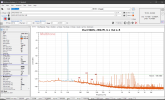Sokel
Master Contributor
- Joined
- Sep 8, 2021
- Messages
- 9,555
- Likes
- 10,260
As visuals are better:This thread has some more information on DSD volume control.

Volume control when playing native DSD files
Hello guys, My system is comprised of an RME ADI-2 DAC, Hegel H20 power amp and Spendor D7 speakers. I am presently playing my CD library from a USB drive attached to my laptop and streaming Qobuz from the same laptop, connected by USB to the DAC. The problem is that, if I want to play DSD files...www.audiosciencereview.com
Quoting MC_RME's post #11:
I try. As mentioned DoP is native DSD, the OP got confused with the two DSD playback modes of the ADI-2 DAC, Direct (no volume control) and 'normal' (the DAC chip converts DSD to PCM to be able to use volume control. Conversion and volume control happen directly in the DAC chip, while in PCM mode volume control is done by RME in the FPGA).For many years most DACs used that internal conversion to PCM without telling the user. DACs with ESS chips have a digital volume control that claims to not use PCM conversion. The technique behind it is not disclosed by ESS, all we hear is third party wisdom about it, so pardon me to be sceptical.Regarding USB: indeed doesn't support DSD. DoP is a clever way to circumvent this restriction. Popular by the many DACs using an XMOS USB chip is a different, but basically identical workaround. Again PCM bits are used to transfer DSD, but in a so called Alternate Setting. Class Compliant devices can have several Alternate Settings, thus offering different modes (max sample rate, amount of channels and bit resolution). An operating system will only use the first Alternate Setting by default. The XMOS drivers are able to activate that other mode and then can transfer DSD via 32 bit PCM. The advantage is simlar to DoP: as this mode is hidden and normally not activated, the user will not have a blast of full level white noise when playing DSD via PCM.


PCM 96kHz and DSD128 native baseline/sanity check
Now level is reduced by DAC's side,signal used is 100Hz and lots of averages for easy low-dirt view :

PCM 96kHz at -12dB

DSD128 at -12dB

Both for easy view